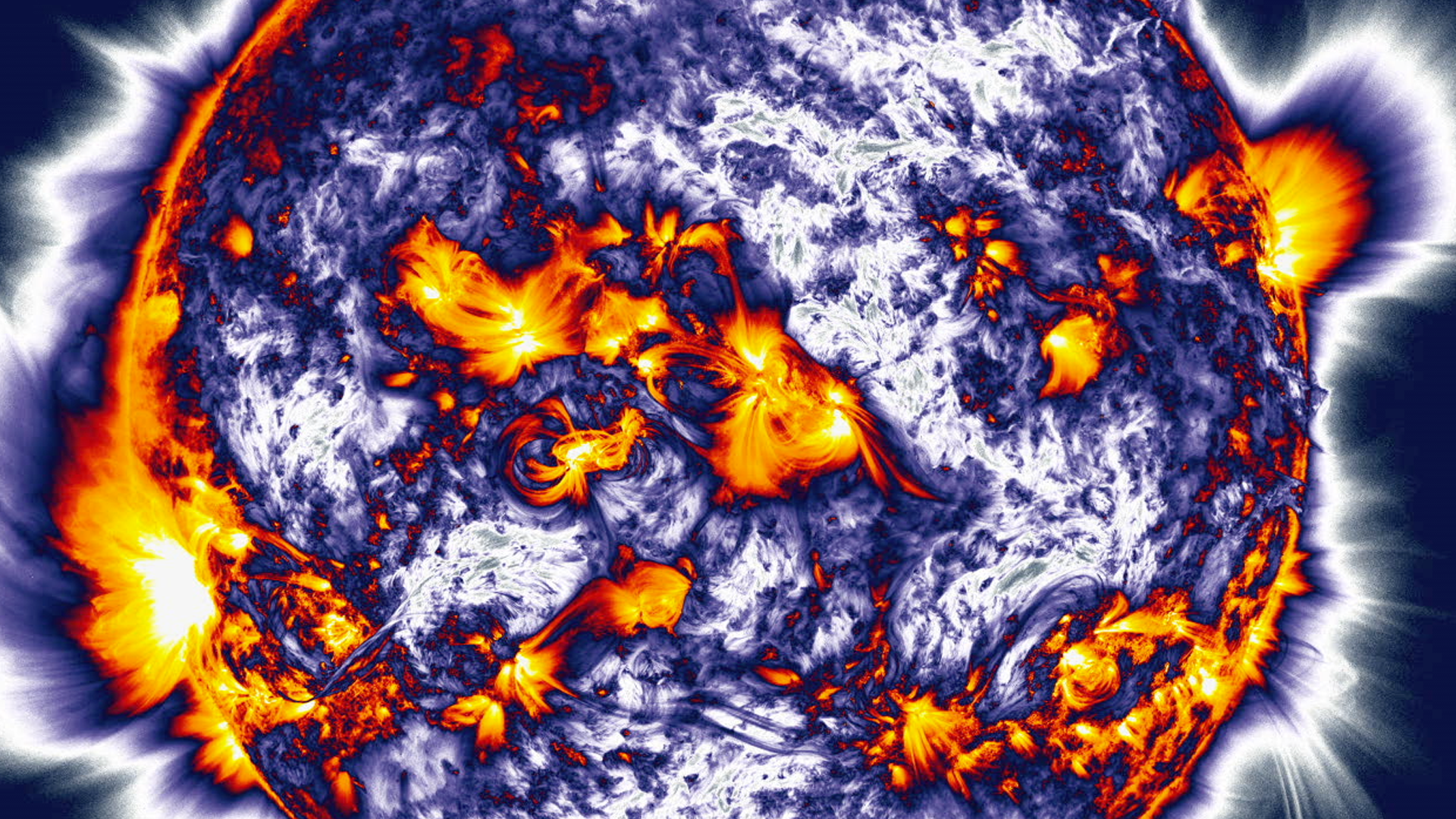‘The sun is slowly waking up’: NASA warns that there may be more extreme space weather for decades to come
By Harry Baker
Copyright livescience

Skip to main content
Close main menu
Live Science
Sign up to our newsletter
View Profile
Search Live Science
Planet Earth
Archaeology
Physics & Math
Human Behavior
Science news
Life’s Little Mysteries
Science quizzes
Newsletters
Story archive
Skyscraper-sized asteroid flyby
Diagnostic dilemma
Elusive ‘grumpy’ cat photographed
Anthropologist Ella Al-Shamahi on human origins
How misinformation spreads
Don’t miss these
Gigantic ‘letter S’ spotted on the sun just before a ‘dark eruption’ hurls a fiery shadow at Earth
‘Space hurricane’ caught raging over North Pole during one of the sun’s quietest days
‘Cannibal’ solar storm could paint auroras above 18 US states this Labor Day
Parker Solar Probe captures closest-ever photos of the sun during record-breaking flight
Artificial Intelligence
IBM and NASA create first-of-its-kind AI that can accurately predict violent solar flares
Solar tornado rages on the sun as a giant plasma plume erupts
Auroras may be visible from 18 states this weekend as solar storm barrels toward Earth
Behold, ‘The Beast’: Gigantic animal-like plasma plume 13 times wider than Earth hovers over the sun
‘Never been seen before’: First images from new ISS solar telescope reveal subtle ‘fluctuations’ in sun’s outer atmosphere
Sun ‘hole’ expected to produce intense auroras tonight, potentially visible from 15 US states
Scientists unveil most detailed photo of a solar flare ever taken
Rivers & Oceans
96% of oceans worldwide experienced extreme heatwaves in 2023, new study finds
Climate change
Key Atlantic current could start collapsing as early as 2055, new study finds
Astrophotographer snaps ‘once-in-a-lifetime’ shot of solar flare photobombing the ISS
Planet Earth
Science news this week: Storms rage on Earth and the sun, and a new moon is spotted around Uranus
‘The sun is slowly waking up’: NASA warns that there may be more extreme space weather for decades to come
Harry Baker
17 September 2025
A new NASA study suggests that solar activity will remain high or rise further in the coming decades, contradicting previous assumptions that the sun was quieting down — and scientists “don’t completely understand” why.
When you purchase through links on our site, we may earn an affiliate commission. Here’s how it works.
A new NASA study suggests that solar activity will remain high over the coming decades, potentially leading to more dangerous space weather.
(Image credit: NASA Goddard)
NASA scientists are warning that the sun may be “waking up” from a brief period of relative inactivity, contradicting past assumptions about our home star. If true, this could mean that decades of potentially dangerous space weather are in store.
The sun follows a roughly 11-year cycle of solar activity that begins with a prolonged quiet period, known as solar minimum, and builds toward an explosive peak, known as solar maximum — when our home star frequently spits out powerful solar storms at us. This pattern is known as the “sunspot cycle,” because the number of dark patches on the sun’s surface rises and falls with solar activity. The sunspot cycle is, in turn, governed by a longer 22-year cycle, known as the Hale Cycle — during which the sun’s magnetic field entirely flips and then reverses back again.
But in addition to the sunspot and Hale cycles, the sun also experiences long-term fluctuations in solar activity that can span multiple decades and are much harder to predict or explain. Examples include periods between 1645 to 1715, known as the Maunder Minimum, and between 1790 and 1830, known as the Dalton Minimum, when solar activity was generally much lower throughout successive sunspot cycles.
You may like
Gigantic ‘letter S’ spotted on the sun just before a ‘dark eruption’ hurls a fiery shadow at Earth
‘Space hurricane’ caught raging over North Pole during one of the sun’s quietest days
‘Cannibal’ solar storm could paint auroras above 18 US states this Labor Day
Back in the early 2000s, downward trending solar activity led some scientists to believe that we were possibly entering a new “deep solar minimum.” This theory gained traction after the last solar maximum, between 2013 and 2014, which was much weaker than previous cycles. However, the current sunspot cycle, which has just peaked, has massively upended this theory.
In a new study, published Sept. 8 in The Astrophysical Journal Letters, researchers analyzed multiple metrics of solar activity, including solar wind, magnetic field strength and sunspot numbers, and found that they have been on an upward trend since around 2008, and could rise further over future cycles, suggesting that the deep solar minimum theory is well and truly dead.
Related: 10 supercharged solar storms that blew us away in 2024
The sun’s roughly 11-year cycle is named after the sunspots that rise and fall with solar activity. This timelapse image shows all the sunspots that appeared in August 2024, when the number of sunspots peaked. (Image credit: SDO/Şenol Şanlı/Uğur İkizler)
“All signs were pointing to the sun going into a prolonged phase of low activity,” study lead author Jamie Jasinski, a plasma physicist at NASA’s Jet Propulsion Laboratory in Southern California, said in a NASA statement. “So it was a surprise to see that trend reversed. The sun is slowly waking up.”
Sign up for the Live Science daily newsletter now
Get the world’s most fascinating discoveries delivered straight to your inbox.
Contact me with news and offers from other Future brandsReceive email from us on behalf of our trusted partners or sponsorsBy submitting your information you agree to the Terms & Conditions and Privacy Policy and are aged 16 or over.
We are currently coming towards the end of the sun’s most recent solar maximum, which officially began in early 2024, and it has not played out as expected.
When the current sunspot cycle began in late 2019, experts from the Space Weather Prediction Center (SWPC) — which includes scientists from NASA and the National Oceanographic and Atmospheric Administration (NOAA) — predicted that solar maximum would most likely begin sometime in 2025 and be comparable to the previous weaker cycle.
The maximum number of visible sunspots during the previous solar maximum was the lowest for almost 100 years. (Image credit: NOAA/SWPC)
However, as the current cycle progressed, it quickly became clear that this was not the case and that solar maximum would arrive sooner and be much more active than initially predicted. SWPC scientists later acknowledged their mistake, issuing their first-ever updated forecast, which came just in time for solar maximum’s arrival.
You may like
Gigantic ‘letter S’ spotted on the sun just before a ‘dark eruption’ hurls a fiery shadow at Earth
‘Space hurricane’ caught raging over North Pole during one of the sun’s quietest days
‘Cannibal’ solar storm could paint auroras above 18 US states this Labor Day
Since then, the sun has reached its highest number of sunspots in more than 20 years and spat out a record number of powerful X-class flares — the most powerful type of explosion the sun is capable of producing.
During the current maximum, Earth has also been hit by several major geomagnetic storms, or disturbances to the planet’s magnetic field. The most noteworthy was an “extreme” event in May 2024, which triggered some of the most vibrant aurora displays in centuries and caused over $500 million in damages.
The sun has frequently spat out solar storms during solar maximum. This “dark” coronal mass ejection was launched on Sept. 7, 2025 and triggered a minor geomagnetic storm on Earth. (Image credit: NASA/SDO)
Now, the new study warns that what we have witnessed over the past few years will likely become the “status quo” over the next few decades. This could be especially problematic because humanity has become much more reliant on technologies that are prone to interference from space weather, such as power grids, GPS-controlled machinery and Earth-orbiting satellites, which can be knocked out of the sky by solar storms.
RELATED STORIES
—We are fast approaching the sun’s ‘battle zone’ — and it could be even worse than solar maximum, experts warn
—’Like they were demon possessed’: Geomagnetic super storms are causing tractors to dance from side to side across US farms
—No, you didn’t see a solar flare during the total eclipse — but you may have seen something just as special
It is currently unclear why the sun experienced a blip in solar activity over the last few decades or what may be driving its current resurgence: “The longer-term trends are a lot less predictable and are something we don’t completely understand yet,” Jasinski said.
Another study from earlier this year proposed that the recent surge in activity could be part of a lesser-known and understudied 100-year solar cycle, known as the Centennial Gleissberg Cycle. However, the newest study does not mention this at all.
solar maximum
Harry Baker
Social Links Navigation
Senior Staff Writer
Harry is a U.K.-based senior staff writer at Live Science. He studied marine biology at the University of Exeter before training to become a journalist. He covers a wide range of topics including space exploration, planetary science, space weather, climate change, animal behavior and paleontology. His recent work on the solar maximum won “best space submission” at the 2024 Aerospace Media Awards and was shortlisted in the “top scoop” category at the NCTJ Awards for Excellence in 2023. He also writes Live Science’s weekly Earth from space series.
You must confirm your public display name before commenting
Please logout and then login again, you will then be prompted to enter your display name.
Gigantic ‘letter S’ spotted on the sun just before a ‘dark eruption’ hurls a fiery shadow at Earth
‘Space hurricane’ caught raging over North Pole during one of the sun’s quietest days
‘Cannibal’ solar storm could paint auroras above 18 US states this Labor Day
Parker Solar Probe captures closest-ever photos of the sun during record-breaking flight
IBM and NASA create first-of-its-kind AI that can accurately predict violent solar flares
Solar tornado rages on the sun as a giant plasma plume erupts
Latest in The Sun
Gigantic ‘letter S’ spotted on the sun just before a ‘dark eruption’ hurls a fiery shadow at Earth
‘Cannibal’ solar storm could paint auroras above 18 US states this Labor Day
Scientists unveil most detailed photo of a solar flare ever taken
Solar tornado rages on the sun as a giant plasma plume erupts
NASA spacecraft snaps images of lunar transit and Earth eclipse on the same day — see the photos
Behold, ‘The Beast’: Gigantic animal-like plasma plume 13 times wider than Earth hovers over the sun
Latest in News
‘The sun is slowly waking up’: NASA warns that there may be more extreme space weather for decades to come
Anthropologist claims hand positions on 1,300-year-old Maya altar have a deeper meaning
1,900-year-old ‘treasure’ found in Roman-era family’s scorched house in Romania
Grumpy-looking Pallas’s cat photographed by camera trap in stunning photo from eastern Himalayas
Skyscraper-size asteroid previously predicted to hit us in 60 years will zoom past Earth on Thursday (Sept. 18) — and you can see it live
‘This needs to happen fast’: Scientists race to cryopreserve a critically endangered tree before it goes extinct
LATEST ARTICLES
Anthropologist claims hand positions on 1,300-year-old Maya altar have a deeper meaning
A knife broke off in a man’s chest, and he didn’t notice it for 8 years
‘When people gather in groups, bizarre behaviors often emerge’: How the rise of online social networks has catapulted dysfunctional thinking
A tragic gene therapy death that stalled the field for a decade — Sept. 17, 1999
‘We certainly weren’t exceptional, but now we’re the only ones left’: In new PBS series ‘Human,’ anthropologist Ella Al-Shamahi explores how humans came to dominate Earth
Live Science is part of Future US Inc, an international media group and leading digital publisher. Visit our corporate site.
Contact Future’s experts
Terms and conditions
Privacy policy
Cookies policy
Accessibility Statement
Advertise with us
Web notifications
Editorial standards
How to pitch a story to us
Future US, Inc. Full 7th Floor, 130 West 42nd Street,
Please login or signup to comment
Please wait…



